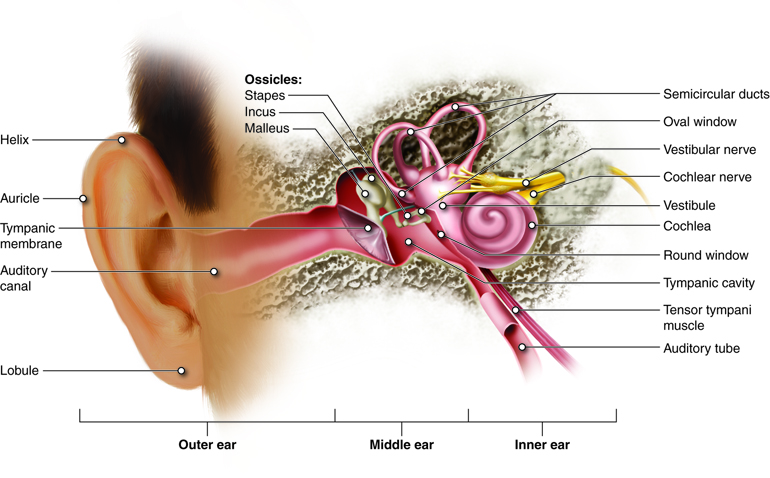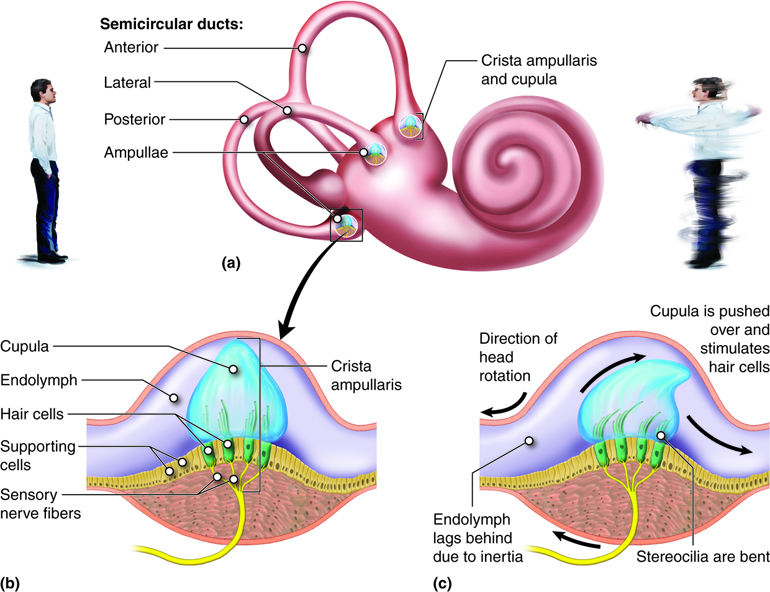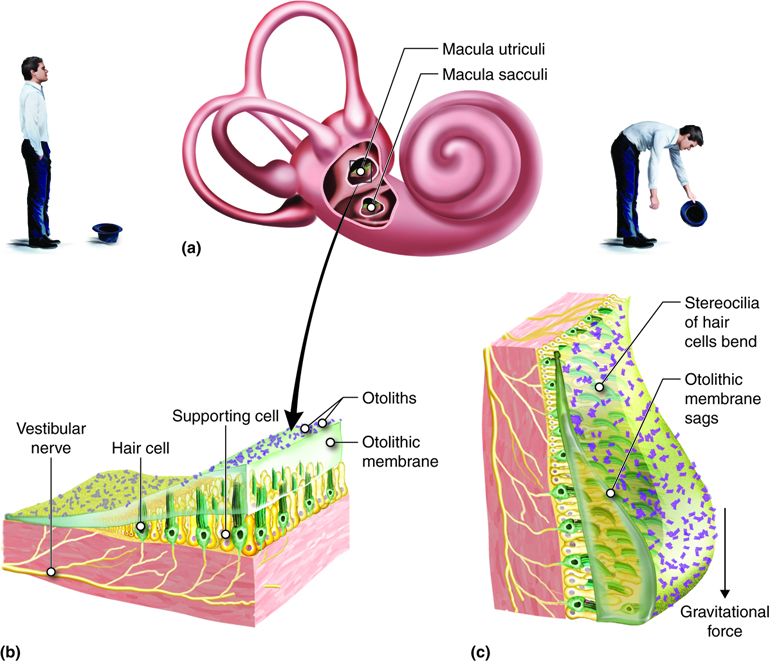Proprioception: Balance and Phantom Limbs
25
Learning Objectives
Distinguish the roles of the semicircular canals, the saccule, and the utricle.
Describe how hair cells transduce linear or angular acceleration.
Explain why some people get the spins when they’ve consumed a lot of alcohol.
The vestibular system is responsible for detecting head motion and maintaining balance. The sensory organs that support balance are in the inner ear.

In the vestibular system, there are three semicircular canals and two otolithic receptors, the saccule and utricle. Semicircular canals transduce, or convert, the physical energy of rotational angular accelerations into neural impulses while the utricle and saccule transduce the physical energy of linear accelerations into neural impulses. The three semicircular canals lie perpendicular to each other.

The utricle senses motion in the horizontal plane, and the saccule senses motion in the vertical plane. All together the canals and the otolithic receptors respond to head motion and maintain static head position relative to gravity in all directions in 3D space.


Within semicircular canals, an enlarged region called the ampulla holds hair cells that are able to respond to rotational movement. These cells have stereocilia, or action-based protrusions required for hearing and balance, that project outward into a gel called the cupula. These stereocilia are staggered so the shortest protrusions are on one side of the cell while the taller protrusions are on the opposite side (Fig.3.5.1). When the head rotates, the fluid endolymph in the semicircular canals lags behind the head motion and pushes the cupula in the opposite direction of the head movement. If the cupula pushes the stereocilia toward the tall end, the ion gated channels open which depolarizes the cell and increases the release of neurotransmitters. Conversely, the cell becomes hyperpolarized when the stereocilia are pushed towards the shorter end. Since left and right ear semicircular canals have opposite polarity, by comparing the movements of the stereocilia, the sensory nerve fibers are able to send signals that allow the brain to detect head rotation. The otolith receptors have stereocilia that extend into a gelatin membrane that is covered by a layer of calcium carbonate crystals known as the otoconia. The otoconia are displaced by linear accelerations, not by fluid movement like in the semicircular canals. When otoconia move, they bend the hair cells and open or close the iona gated channels. The hair cells in the otolith layer are organized differently than those in the semicircular canals. The tallest stereocilia are pointed toward the center of the utricle and away from the center of the saccule.
Alcohol can cause a person to get the spins because it interferes with the vestibular system. At least one semicircular canal is affected. Alcohol has a lighter density than the fluid in the semicircular canal, endolymph, so when alcohol is consumed, the alcohol changes the buoyancy of the endolymph. The cupula is more prone to shifting because of the lighter density of the endolymph and this shifting of the cupula causes the hair cells to shift and send signals. Linear acceleration results in a shift in the cupula of the semicircular canals, and is interpreted as angular acceleration. This process can start at a fairly low blood alcohol content (BAC) and is a major reason why it is illegal to drive with a BAC of 0.08 or above.
The Khan Academy video linked here and included below provides some additional information about the vestibular system.
CC LICENSED CONTENT, SHARED PREVIOUSLY
NOBA, The Vestibular System.
Provided by: Baylor College of Medicine
URL: https://nobaproject.com/textbooks/psychology-as-a-biological-science/modules/the-vestibular-system
License: CC BY-NC-SA 4.0
Adapted by: Anna Maunu
Cheryl Olman PSY 3031 Detailed Outline
Provided by: University of Minnesota
Download for free at http://vision.psych.umn.edu/users/caolman/courses/PSY3031/
License of original source: CC Attribution 4.0
Adapted by: Anna Maunu

